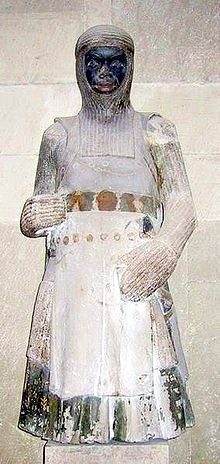Record skirt

The so-called plate skirt (also outdated: clasp armor ) was probably created in the course of the second half of the 13th century , when the protection offered by chain armor alone was no longer sufficient, presumably especially under the experience of the increasing use of long-range weapons (crossbow, Bow weapons). At that time the contemporary designation as Plâten is often found .
A plate skirt consisted of several overlapping iron plates that were attached to the inside of a throw and, due to its rigid shape, only protected the torso. Finds such as the plate skirt of Zacharias Haderer in the Bavarian Army Museum in Ingolstadt or from mass graves from the battle of Visby (1361) give a good impression of the diversity of the structure.
Various materials can be used as a carrier, including leather, or solid cloth made of z. B. Linen. Later successor types , the brigantines or corrazines, tend to have linen. A higher quality cloth was usually used as the cover material, e.g. B. silk or silk velvet. The panels were riveted to the inside of the support by means of rivets, which could either be made of iron or, as the representations suggested, made of non-ferrous metal. These rivets were clearly visible from the outside and often had artistically designed heads.
The partial overlap and the rigid arrangement on the inside of the carrier material ensured that there were no vulnerable gaps.
From the first half of the 15th century , on the one hand, the brigantine with significantly smaller plates developed, and on the other, the plate armor , which over time completely replaced the plate skirt.
literature
- Wsewolod Arendt: Contributions to the emergence of the clasp armor - an old Turkish weapon find from Kerch . In: Journal of historical weapons and costume studies, complete series, vol. 13 (new series, vol. 4) . Berlin, 1932/34, pp. 49-55
- Werner Fleischhauer: Buckle armor found at Helfenstein Castle . In: Journal of historical weapons and costume studies, complete series, vol. 13 (new series, vol. 4) . Berlin, 1932/34, pp. 250-252
- EA Gessler: A new armor discovery in Switzerland . In: Journal of historical weapons and costume studies, complete series, vol. 13 (new series, vol. 4) . Berlin, 1932/34, pp. 107-109
- Markus Tremmel: The knight's last battle, Zacharias . In: Bayerische Archäologie , 3, 2007, pp. 19–21. Taufkirchen, 2007
- Francis M. Kelly: On the origin of the clasp armor - addendum . In: Journal of historical weapons and costume studies, complete series, vol. 13 (new series, vol. 4) . Berlin, 1932/34, pp. 105-106
- Francis M. Kelly: Further notes on buckle armor and related forms of protective weapons on art monuments of the 14th century . In: Journal of historical weapons and costume studies, complete series, vol. 13 (new series, vol. 4) . Berlin, 1932/34, pp. 166-168
- Bengt Thordeman: Armor of the battle of Wisby 1361 . Text and chalkboard. - Uppsala, 1939/40
- Bengt Thordeman: On the origin of the clasp armor . In: Journal of historical weapons and costume studies, complete series, vol. 13 (new series, vol. 4 ). Berlin, 1932/34, pp. 56-59
Web links
- [1] Zacharias Haderer's record rock in the 2007 online auction catalog
Individual evidence
- ↑ Ulrich Lehnart: Clothing and weapons of the late Gothic II. 1370-1420. Wald-Michelbach 2003.